[/caption]
Early this morning in the Californian Mojave Desert, Richard Branson and Burt Rutan unveiled the completed Virgin Galactic Mothership “Eve,” the first time this highly secretive project has seen the light of day. This is a significant moment for both Virgin Galactic and Scaled Composites, the company that built Eve, as it shows space tourism is only a heartbeat away. Now we await the completion of SpaceShipTwo that is expected to begin test flights with Eve by 2009.
The rollout represents another major milestone in Virgin Galactic’s quest to launch the world’s first private, environmentally benign, space access system for people, payload and science. – Virgin Galactic rollout press release (July 28th).
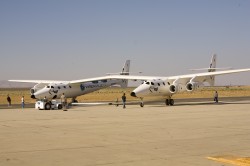
Eve is a large aircraft, with a wing span of 140 feet (42.7 meters), constructed from the world’s longest single carbon composite aviation component ever manufactured. Eve is basically a flying wing with two fuselages plus four efficient Pratt and Whitney PW308A engines attached. During operational flight sometime late 2009 or early 2010, it is hoped the mother ship will fly four times a day, carrying SpaceShipTwo up to 50,000 ft (9.5 miles) high. Once the aircraft reaches 50,000 ft, the spaceship will detach and ignite its rocket engines, blasting six fee-paying space tourists and two pilots to an altitude of around 360,000 feet (68 miles). This is considered to be the edge of space, allowing the SpaceShipTwo occupants five minutes of weightlessness before starting their journey back to Earth.
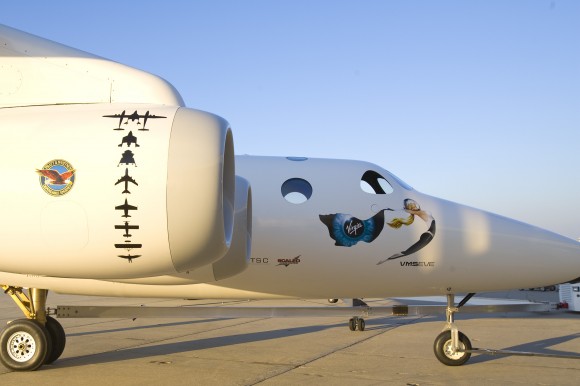
Today’s rollout onto the airstrip of Mojave Air and Space Port was witnessed by government officials, business partners and the future Virgin Galactic space tourists. Eve, named in honour of Branson’s mother, is the first WhiteKnightTwo aircraft of two that are on order with Scaled Composites. A total of five SpaceShipTwo’s are expected to complete the fleet.
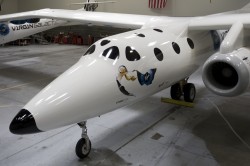
Today’s press release also states: “Driven by a demanding performance specification set by Virgin Galactic, WhiteKnightTwo has a unique heavy lift, high altitude capability and an open architecture driven design which provides for maximum versatility in the weight, mass and volume of its payload potential. It has the power, strength and maneuverability to provide for pre space-flight, positive G force and zero G astronaut training as well as a lift capability which is over 30% greater than that represented by a fully crewed SpaceShipTwo.”
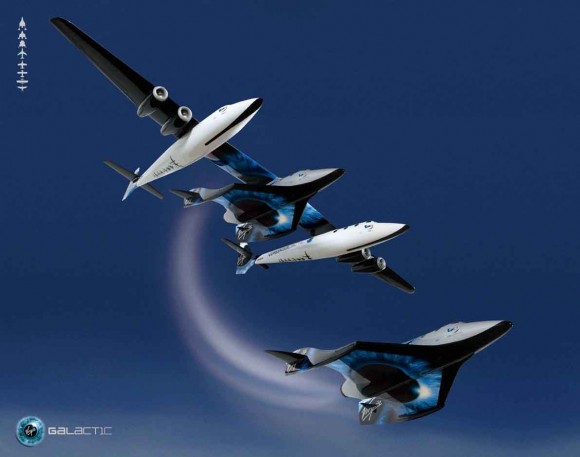
Fights with Virgin Galactic currently cost a hefty $200,000, but this ticket price is likely to fall in time. Over 200 tickets have already been sold. Initially, the company is offering sub-orbital space flights, but eventually Branson wants to push one stage further and begin offering tourists orbital space flight. The entrepreneur has even more optimistic ideas for his future space tourist empire including sending people into space during an aurora, space hotels and trips to the Moon. To be honest, I’d be excited to try out that rocket ride into space after the leisurely flight attached to WhiteKnightTwo…
Sources: Virgin Galactic, ITWire

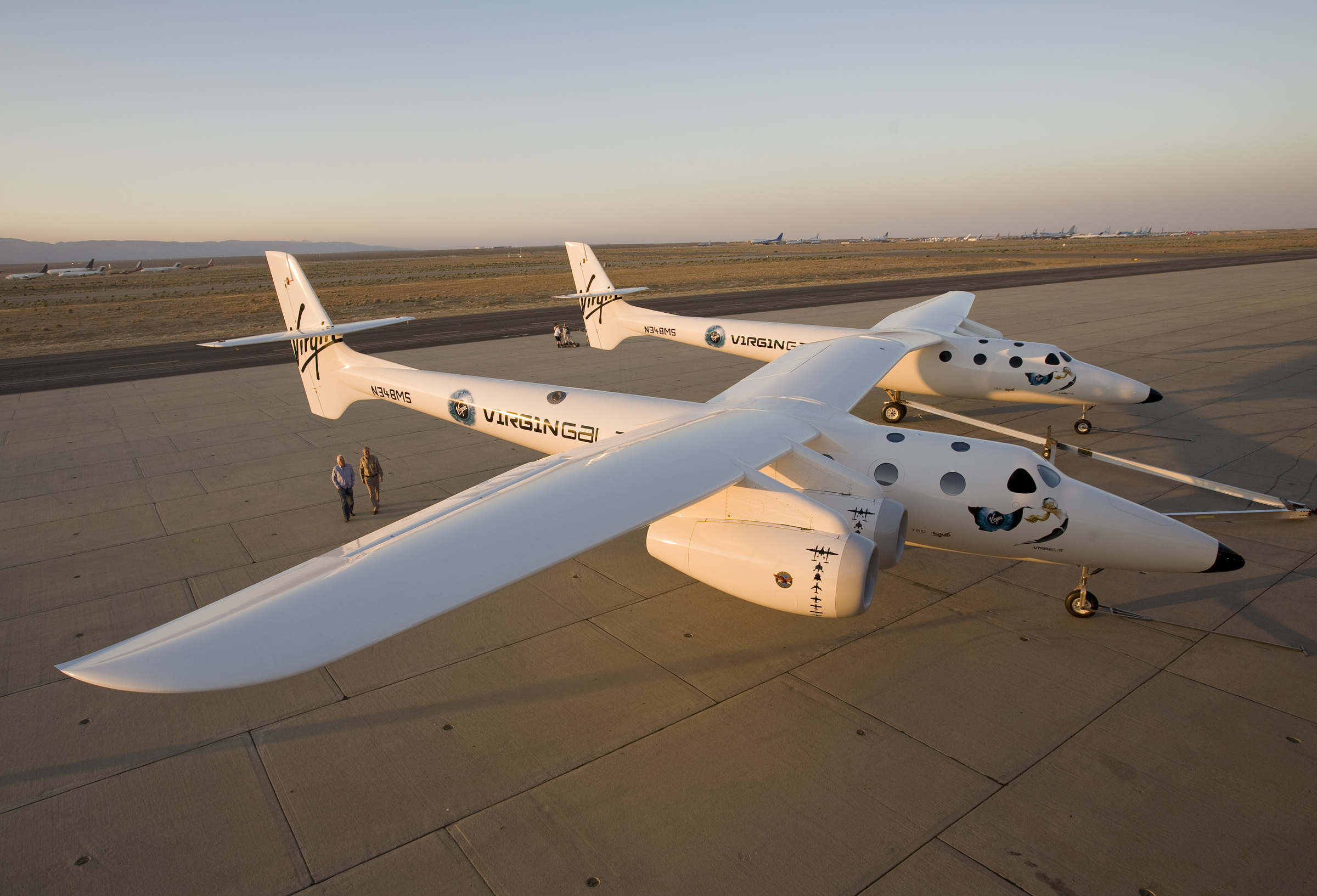
Hi Sili. Funny you should mention that, I was considering that myself. Satellites are launched into low Earth orbit using the Pegasus launch system (http://en.wikipedia.org/wiki/Pegasus_rocket) with the requirement of an altitude of 40,000 ft. I suppose the limiting factor would be payload weight, will be interested to find this out….
Cheers, Ian
Thank you Don, I’ll check it out 😉
Cheers! Ian
Indeed a monumental event for commercial space ventures…private funding is key to the long term success of space exploration.
At the same time, a monumental event for the elite 1% of the world’s population with $200k to spare.
I doubt the price will come down any time soon, considering the bear market.
Would using this plane (or something similar) offer any avantage in launching payloads?
Is it possible to reach a commercial orbit by launching an unmanned rocket stage from it? Would it even be economically interestiing to save a mere 100 km?
D’oh! 15 km! Even less of a save, but if it’s enough to cheapen manned flight, perhpaps it’d help enough for orbital insertion too (though of course that last stage can’t be reused, so I guess that reduces the potential savings enourmously).
Indeed, people have given thought to using WhiteKnightTwo as a satellite launcher. 15 km less height doesn’t sound like much, but please consider you have less than 10% of the atmosphere (in terms of column density) to tunnel through, and are already at several hundred miles/h…
That already makes a big difference. For lightweight LEO payloads, it’s probably quite a bit more economic than launching from the ground. And I’m pretty sure the payload would be larger than with the Pegasus.
PS.: Ian, in case you haven’t seen it yet, there’s an answer waiting for you concerning your Supernova remnant question.
There are several things to consider when figuring cost to get something into space. Launch lattitude, type of orbit, declination of orbit, distance from launch to initial orbit and weight.
Weight is by far the most costly, and it isn’t proportional. Say you need 2000 pounds of fuel for one pound of payload (the sick part is there comes a point where you really start to consider fuel as payload); if you want two pounds of payload, your fuel weight may be 6600 pounds of fuel, not 4000.
Orbit is another costly item. The higher you go, the longer distance you have to travel, and since most orbits tend to follow the shape of the earth, you don’t fly straight up. Again, this distance horizontally is disproportionate to distance vertically and dependent on orbit type. So if you want to increase your orbit by 20 km in height, you will have to travel around 80-100 km horizontal distance; which means more burn time and more weight (ie fuel becomes payload now) you need more fuel to carry the weight of the extra fuel.
So definitely launching at 40,000 feet vs. sea level will save you some fuel; proably around 5-10 percent (more for a really light load to a low orbit). Pretty close to the amount of fuel it would take for you to get to this height (plus horizontal distance depending on the other factors).
Still to launch a medium size satellite into LEO the rest of the way would still take more fuel than a B52 could carry. So this option is only available for very small payloads.
No, Space Ship Two isnt a small payload but… A huge difference with Space Ship Two which goes barely into LEO for 5 minutes and a satellite into a decent LEO for years is the speed it must achieve. The satellite has to get to a speed of over 18,000 mph, space ship two will not need to go near as fast.
Not to mention, for most satellites low earth orbit isn’t the best choice of locations, but that is a different mini-lecture.
David R.:
“At the same time, a monumental event for the elite 1% of the world’s population with $200k to spare. ”
Yes, but you have to start somewhere. The more you can demonstrante a market, the sooner you can expect more development and lower prices.
Sill:
“Would using this plane (or something similar) offer any avantage in launching payloads?”
Yes you could. White Knight can just as well fucntion as an air-launcher for a small expendable orbital rocket.
White Knight I did some seperation and drop tests for T/Space to this end, several years ago.
>> Pretty close to the amount of fuel it would take for you to get to this height (plus horizontal distance depending on the other factors).
The problem is not saving fuel, its saving the cost of the disposable stages that were either spent or had to be recovered and re-certified after every flight.
Air launch means the first stage is a normal aircraft that can be serviced by regular technicians and conduct multiple launches between overhauls.
On a different note I would like to point out that its the rich snobs who pay for overpriced things that make much of what we take for granted today possible.
They were the first to invest in airlines, cars, fast ships and fancy computerized gadgets. They were the ones that got the government and big business looking at the potential of these things.
Given time I believe they will herald the future of space travel for the masses, since they will be the ones who build the competitive private market.
Much as the blatant display of wealth may annoy folks, in this case its best to restrain ones hate.
Maxwell,
Re-read. I didn’t say the problem was fuel; the problem is weight. Any structure savings figures into it, but compared to fuel it really isn’t a huge ratio. There are quite a few minor details I didn’t cover. I really didn’t want to write a full dissertation.
I don’t understand what you mean, “saving the cost of disposable stages that were spent or had to be recovered”.
You’re saying it costs more to use re-useable solid fuel boosters than it does to build/maintain a launch plane? Well, if you’re launching anything with weight, it doesn’t matter. We can’t air launch large payloads at this time into a sustained orbit from an aircraft.
Like I said with air launch, at this time it is only feasible with small light payloads. A savings of 40,000 feet (less than 8 miles) when you are launching something into an orbit of 120+ miles and attempting to achieve 18,000+mph isn’t a great deal.
If it was as you say, it would be used a great deal. In fact, it would be used any time something was put into LEO… but it isn’t.
And you thought that round-trip ticket from New York to L.A. was expensive.
Actually, you’re not going to outer space for the $200K. You only get sub-orbital space (about 70 miles up). While a press release offered details on advanced avionics and other such stuff, there was no word if peanuts would be served or if an in-flight movie is available.
Frank Glover:
“Yes, but you have to start somewhere. The more you can demonstrante a market, the sooner you can expect more development and lower prices.”
Yes, I agree. A market must be established first, and with high costs you must look at the client(s) who will both consume and invest in your product. I do not believe this particular market will expand enough to attract a middle-income consumer in the near future without a focused effort. Private industry has two opportunities. First, it clearly has potential to exploit a new market, thus rapidly developing space exploration. Second, it has the opportunity to open that market to a very large number of people. Private enterprise can set a very positive tone IF it wants to. The question is whether it will. In this economy, I don’t see it happening without at least some basic regulation.
One point on satellite launch: pads on the ground can be quite expensive to maintain, esp. if you’re only using it once a year… now if you could rent a WhiteKnightTwo for those one or two flights per year, you could save a bundle. Orbital wanted to rent a plane to launch Pegasus, but got stuck buying one instead. Painful to have to keep an aircraft in a hanger, and maintain it, only for a two or three flights once a year…
There must be some kind of magic going on in that design, because anyone with common sense can see how the shared wing is ridiculously stressed from opposite lateral forces on the tails. I’m surprized they haven’t cracked it just pushing it around on the ground.
Virgin Galactic representatives have stated on several occasions that WhiteKnightTwo can be used for launching small satellites into LEO so I guess they must have done some math in order to come to that conclusion. Of course they didn’t say how small satellites and how low an orbit, but still… They appear to count on making some money on launching payloads into orbit so the parameters must be somewhat reasonable.
/Adam